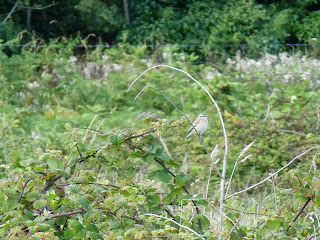A flock of around 50 juvenile and adult shags were close to shore, some sat on the water with their wings held open, and scanning through them I found a smart winter plumaged red throated diver. Further out was a second diver in summer plumage but it flew off before I could get a good look at it. Later on I found both divers together much closer to shore and I was able to identify it as a smart summer plumaged red throated diver.
The Bight had a large roost of waders at high tide and it was nice to see more small waders than last year although numbers are still much reduced than previous years, the small waders seem to be favouring Topsham and Bowling Green Marsh further up the River Exe. Amongst the curlew, bar tailed godwit, oystercatcher, dunlin, sanderling and ringed plover I found 2 knot and a black tailed godwit. Also feeding amongst the weedy edge of The Bight were a wheatear and a yellow wagtail with linnets, skylarks and meadow pipits.
I spent some time wandering around the car park bushes looking for a reported juvenile rose coloured starling but I was out of luck, finding just adult and juvenile starlings instead. They were quite schizophrenic in their behaviour, being shy and retiring while feeding on blackberrys in the bushes before flying off to the food stalls at The Warren to try and grab scraps of chips and doughnuts from the tourists.
I also managed to see whitethroat, swallow, chiffchaff and blackcap and searching around I found some Autumn lady's tresses in flower. Small coppers were much in evidence, with a pair of mating common darter and an emperor dragonfly also seen.
Autumn Lady's Tresses
Robins pincushion - bedeguar gall on wild rose caused by the gall wasp Diplolepis rosae
Mating Common Darter - a very blue coloured female with yellow stripes on the legs
Small Copper - caeruleopunctata form
Meadow Brown with usual form of Small Copper
Mothing in the back yard has been uneventful with the usual moths being seen but 6 large ranunculus was my highest garden catch and nice to see. A grey wagtail and a meadow pipit were heard overhead while I was going through the trap on a very misty morning.
Six Large Ranunculus in the Back Yard Moth Trap
Walks at Wembury have been pleasant but uneventful too. Highlights have been Sandwich tern, whitethroat, wheatear, chiffchaff, blackcap and swallow, with 4 bar-tailed godwit (on the 22nd) down to 3 (on the 24th), and my first turnstone of the Autumn on the 24th. Cirl buntings have been quite showy with 8 seen together on the 24th.
Male Cirl Bunting
Non avian highlights at Wembury have been clouded yellows, common lizards and grey bush crickets along with Chunk pasties from the Beach Cafe!
Female Grey Bush Cricket
Male Grey Bush Cricket
Chrysolina banksi
A visit to Saltram House and gardens on the 23rd was enjoyable and very worthwhile with a new moth and a new dragonfly for me. An orange sallow was found in the summerhouse which I caught and released outside. The caterpillars of this species of moth feed on lime trees and there is a beautiful avenue of mature lime trees in the gardens. A male Southern hawker was seen buzzing around the pond in the gardens but settled long enough on some vegetation for me to photo and ID it before it flew off.
Orange Sallow
Male Southern Hawker




































